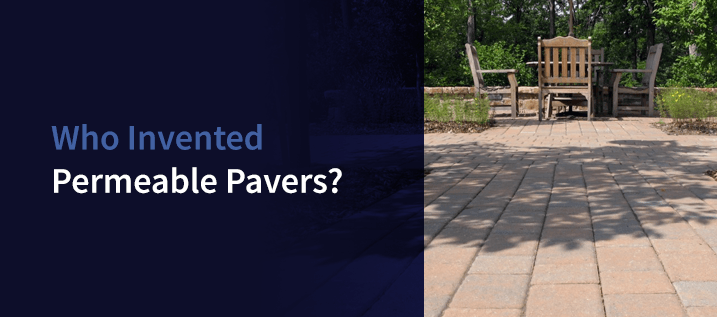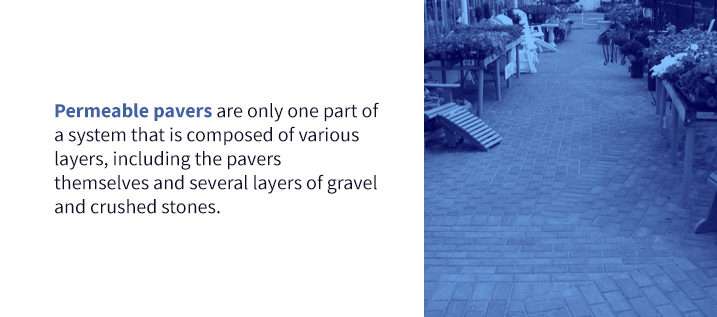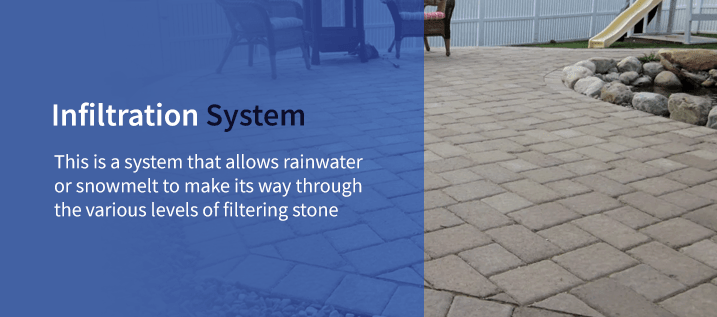Jump To:
- What Is a Permeable Paver?
- Why Use Permeable Pavers?
- Who Invented Permeable Pavers?
- How Do You Build a Driveway, a Patio or Some Other Area Using Permeable Pavers?
Permeable pavers or permeable interlocking concrete pavement (PICP) reduce pressure on already overused sewage systems and reduce pollution in the environment by providing a better way to handle rainwater and snow runoff. Instead of allowing water to merely run off the surface into local drains, often carrying pollutants with it, permeable pavers allow this water to seep between the pavers down to various layers of specifically constructed gravel and soil.
Depending on the kind of system you use, this water then goes back into the groundwater table or is captured and then slowly released back into the drainage system — thus reducing overflow during heavy rainfalls or snow melts.
What Is a Permeable Paver?
Permeable pavers are not exactly permeable. In fact, rainwater or runoff does not filter through the pavers to the specially prepared gravel and soil beneath. Instead, when you lay out a system of permeable pavers, they have gaps between them that allow water to pass through to the various layers underneath.
Permeable pavers are made from fired clay brick or concrete. Crushed aggregate fills the joints between the pavers. This aggregate is composed of crushed quartz, granite or marble and can come in as many as 60 different colors depending upon the design used.

Permeable pavers differ from traditional pavers in several important ways:
- They are thicker than traditional pavers. Permeable pavers are 3 1/8 inches thick (80 mm).
- Traditional, non-permeable pavers are only about 2 3/8 inches thick (roughly 60 mm).
- The secret is the joints. They can vary from between 1/8 of an inch to one half of an inch. These are the spaces that allow the water to filter through.
- The more rainwater you have, or the more snowmelt, the wider the joint.
- Permeable pavers do not use any sand between the joints because it can actually stop the filtration process.
Permeable pavers can be constructed from a variety of materials. The kind you use will depend on where they are installed and how you plan to use them:
- At the simplest level, you can create a paver out of grass or mulch. For instance, you might use this type of permeable paver in a rain garden to keep weeds down but still allow water through.
- Porous pavement is a popular choice for roadways or large areas like parking lots. This type of concrete actually does allow water to filter through as it contains small holes. These holes are created by using a special concrete mixing process.
- Permeable interlocking concrete pavers, the kind we will mostly focus on here, are popular choices for driveways or patios in residential settings. They are designed to resemble a concrete grid, but their joints are a little wider than traditional pavers. Also, the spaces between them are filled with aggregate designed to allow water filtration.
Why Use Permeable Pavers?
Permeable pavers are a popular choice in areas of the mid-Atlantic were local governments are increasingly concerned about stormwater management best practices. One of the reasons there was so much flooding and water damage in Houston after 2017’s Hurricane Harvey was that so much of the concrete used in Houston was impermeable. There was no way for the large amounts of water to do anything but collect on the surface of roads, driveways, parking lots, etc.
As a result, some urban municipalities in the mid-Atlantic have placed restrictions on the amount of runoff that can leave a property. If the total square footage of all the areas with impermeable surfaces is greater than what is allowed under that municipality’s regulations, you need to reduce the size of the footprint of the project, install a rain garden (which could be difficult if you don’t have space) or install permeable pavers.
There are many benefits to using permeable pavers:
- Permeable pavers help return rainfall and snowmelt back into the groundwater table, creating sustainable urban drainage systems. These pavers also help reduce the number of pollutants that find their way back into the water system.
- Pollutants, such as oil, rubber or other chemicals gather on top of paver stones during dry seasons. In areas with traditional impermeable pavers, these pollutants make their way into the regular water system during a rainfall. With permeable pavers, these pollutants are gradually filtered out as the water makes its way through the various levels of aggregate stone. So regardless of your reason for building a permeable paver system, you are ensuring the water that eventually makes its way back into the water table or into the sewer system is much cleaner.
- The installation of a permeable paver system costs about the same as installing a concrete patio or driveway, but it’s about three times as much if you used asphalt. One of the best benefits of the permeable pavers, however, is their durability. You can install them in warm or cold climates. PICPs do not peel or crack like nonpermeable pavers. So while you may have to replace that low-cost asphalt in your driveway three or four times, your permeable pavers will still be in good shape.
- If you live in an area of the mid-Atlantic where you can see your fair share of snow, like northern or western Pennsylvania for instance, permeable pavers are ideal. Since the permeable paver system relies on open aggregates, there are a lot of airspaces in the material. That means water flows into these spaces and freezes, which reduces the possibility of heaving. On the other hand, heat from the earth rises easily through the aggregate. Water does not pool or freeze on the surface, so there is less need for deicing.
- When using permeable pavers, there is less need to reseal or resurface the stones, and repairs are relatively easy. If an individual stone develops a crack or problem it can be removed and replaced.
- If you experience a particularly dry summer or fall in vegetation is dry or sparse, permeable pavers help reduce the possibility of erosion when rain does come.
- When you install permeable pavers, you will likely notice fewer mosquitoes in your patio area because there are fewer standing pools of water in which they can breed.
- When you use permeable pavers, they reduce the accumulation of ice, so there is less chance that you will slip and slide when driving into our out of your driveway.

Permeable pavers don’t just offer advantages for homeowners, though. They can also make contributions to the community:
- Permeable pavers allow water to refill the local groundwater table.
- They improve the quality of local water.
- Light-colored permeable pavers, which are very reflective, can reduce the “heat island” effect. This is why many cities or towns are now requiring that areas like parking lots or large patio areas such as those in front of municipal buildings or other areas, be constructed using permeable paver systems.
- If the water from permeable paver systems is collected, it can reduce a neighborhood or town’s need to use water for landscaping.
- Because permeable pavers return water to the ground and not into storm drainage systems, it can extend the life of a municipality’s sewer system.
Permeable pavers can be used in a variety of locations such as driveways, patios, bike paths, access lanes for emergency vehicles, shoulder areas for roads and on airport runways, sidewalks and parking lots.
As more communities realize that using permeable pavers is an ideal way to improve environmental quality in their areas, manage stormwater runoff and keep their water tables at a healthy level, they are offering rebates and programs for residential and commercial uses.
One great example of this is Prince George’s County in Maryland, which offers a rebate to the Rain Check Rebate Program. The program requires no minimum size when used in a residential setting and 400 square feet when built for a commercial use. The rain check rebate program includes a residential rebate of $12 per square foot up to a grand total of $12,000. That rebate can go as high as $20,000 when used for a commercial business, condominium associations, multi-family dwellings, homeowners’ associations and nonprofit organizations.
A similar rebate program for permeable pavers in D.C. was so popular that it ran out of money for the 2018 calendar year. The government of the district is currently amending the program to put more funding in place.
Montgomery County also has a rebate program for the use of permeable pavers.
These are rebate programs offered in and around the District of Columbia. No matter where you live in the mid-Atlantic, if you’re interested in using permeable pavers, make sure you contact the Department of the Environment in your local municipality or in your state to see if rebates are available for building a permeable paver system.
Who Invented Permeable Pavers?
No one knows for sure who invented these pavers, but they were first used in Europe during the 1800s primarily for load-bearing walls and pavement servicing.
This kind of paver or concrete has been a feature on European roads or in residential areas for more than five decades. Their primary use in the settings was to reduce the effect of floods and rising groundwater tables. With so much of Europe paved with impermeable concrete, the use of this type of material is required in many European cities especially for new construction or roadways.

When it eventually made its way to the United States, probably in the early 90s, permeable pavers and pavement were first used by commercial interests. But it has become an increasingly popular choice for homeowners and developers who want to build in areas with above average amount of rainfall or snow or whose local municipalities have regulations that call for the use of permeable pavers as a way to reduce runoff and increase groundwater.
How Do You Build a Driveway, a Patio or Some Other Area Using Permeable Pavers?
Permeable pavers are only one part of a system that is composed of various layers, including the pavers themselves and several layers of gravel and crushed stones.
If you’re interested in installing permeable pavers around your residence, the first thing you need to do is a test dig. You need to determine what kind of soil is in and around your home. This may not only help determine what kind of aggregate you will use in the layers beneath the pavers, but it will also play an important role in the actual design used when installing the pavers.
For instance, if the predominant soil type around your residence is heavy clay rather than sand or rock, the company that installs the permeable pavers will need to use different installation methods.

Once the soil type has been determined, most paver systems are constructed as follows:
- Dig to the depth that will be required for all the various layers such as a base, a bedding layer and the actual pavers themselves.
- It’s a good idea to lay down some geotextile fabric at this very bottom level. This prevents soil particles from migrating upward into the base but still allows water to seep through to the groundwater table.
- Next comes a subbase layer composed of No.2 stone. The thickness of the layer will depend on the overall design of the system. Once it is in position, compact it.
- Next comes a layer of four to six inches of three-quarter aggregate (in most places known as No. 57 stone). Once the layer is in place it needs to be compacted.
- You’ll need another layer of geotextile fabric on top of his base.
- Now you lay down a layer of at least two inches of one quarter “clean” stone (in most places known as No. 8 stone). Again, compact this layer of stone.
- Now comes time to lay out the pavers in whatever design motif you have decided to use. Make sure they are set and tight, using something like a lug nut as a spacing tool.
- At this point, you are most of the way there. Next, you install your border pavers and the curbing blocks.
- After that, you’ll spread your aggregate stone between the joints of the pavers.
- Your final step is to compact the entire driveway, patio or sidewalk to make sure the fit is tight.
The kind of permeable pavement system you construct also depends on what you plan to do with the runoff water. There are a few options:
Infiltration System
This is a system that allows rainwater or snowmelt to make its way through the various levels of filtering stone and gravel and the geotextile fabric on the very bottom, eventually finding its way back into the water table.
Attenuation System
In this system water also makes its way through the permeable pavers, but it is instead stored temporarily in the layers beneath the paving, which is encased in an impermeable membrane rather than a geotextile fabric. As part of the construction process, an outflow pipe containing holes along its length is placed in the bottom layer and connected to the drainage system. The water is very slowly released into these overflow pipes and back into the drainage system.
This is a good system to use if you already know the water table is high because you live in an area of heavy rainfall, but you don’t want to release too much water all at once back into the drainage system.
Collection System
This system is somewhat like the attenuation system, only instead of diverting the water back into the drainage system, you send it to a reservoir area where the water can then be used for various purposes. For instance, water can be filtered for other uses such as watering gardens, car washes and even waste removal. It’s a great way for the permeable pavers to contribute a valuable resource to the homeowner or to the community.
It’s important when permeable pavers are being installed that you work with a company that has experience in the construction of a permeable paving system. If you hire the wrong person or try to do it on your own, you could end up laying permeable pavers in the same way you would do traditional pavers.
This will not work for a couple of reasons:
- Your patio or driveway is likely to settle unevenly, which will leave you with lots of raised stones or uneven levels.
- It’s very likely that this method of construction will actually subvert the very reason for using permeable pavers — water will not be able to run between the stones. The standard aggregate mix for a regular patio base, when compacted, will not allow any water to run between the very locked particles of aggregate.

This is also a good way to find out whether or not an installer knows what they are doing. A standard impermeable base uses number 21A aggregate. If a potential installer tells you they plan to use 21A or sand as the aggregate between the stones, you need to go with someone else.
To quickly review, the type of aggregate you use when constructing a permeable paver system is the key to making the system work properly.
You want to use an aggregate composed of marble, quartz and granite of varying sizes. The preferred stones are No.2 for the subbase, No. 57 stone for the next layer, then No. 8 for the course bedding layer that will sit just underneath the permeable pavers.
When You’re Looking to Install a Permeable Paver System Contact Nitterhouse Masonry Products
Since 1923, over five generations, Nitterhouse Masonry Products has been serving the mid-Atlantic area. For over 90 years we’ve been offering the best building materials for commercial, industrial and residential customers. We care deeply about the quality of our products, and when you’ve been in business as long as us, your customers become friends — and we’re happy to have them come back, again and again, for our excellent service and products.

Our offerings include architectural blocks, paving stones, natural stone, brick and specialty items. If you’re interested in finding out more about permeable pavers and why they’re such a great choice for anyone who lives in the mid-Atlantic, call us today or contact us online. A member of our team will be happy to discuss options with you.


